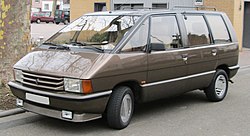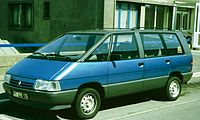Renault Espace I.
| Renault | |
|---|---|
|
Renault Espace (1984-1988)
|
|
| Espace I (type J11) | |
| Sales designation: | Espace |
| Production period: | 1984-1990 |
| Class : | Van |
| Body versions : | Station wagon |
| Engines: |
Otto engines : 2.0–2.2 liters (74–88 kW) Diesel engine : 2.1 liters (65 kW) |
| Length: | 4365 mm |
| Width: | 1777 mm |
| Height: | 1660 mm |
| Wheelbase : | 2580 mm |
| Empty weight : | 1195-1389 kg |
| successor | Renault Espace II |
Renault Espace I (type J11) refers to the first generation of the Espace MPV from Renault .
development
The French car manufacturer Matra developed in 1978 to 1982, a MPV ( Van ) and brought them together in 1984 with Renault as a Renault Espace (= room) for series production.
The vehicle was originally intended for Talbot as the successor to the Talbot-Matra Rancho , a brand belonging to the PSA Peugeot Citroën group, which was discontinued at the end of 1983 . However, PSA saw no market opportunities for the model, and the Talbot brand's continued existence was uncertain. Renault subsequently adopted the concept or the almost finished van and kept the original design almost unchanged. The marketability for this type of automobile was often questioned at first, but later turned out to be a commercial success. Antonis Volanis was responsible for the design .
innovation
It was not only the space concept of the Espace with its seven seats, five of which were individually removable, so that the trunk could be expanded to 3 cubic meters of cargo space, that paved the way, but especially the multi-layer polyester structure developed by the automotive manufacturer Matra, which is experienced in plastic body construction .
The body skeleton of the Espace, consisting of the floor assembly made from pressed sheet steel parts, the front bulkhead as well as the roof frame and pillars, is first spot-welded and then completely hot-dip galvanized as a prefabricated part . The fully assembled steel structure is immersed in a bath with 350 tons of zinc for eight minutes, resulting in a 65 micrometer thin zinc layer on the steel, which is approx. 30 kg per vehicle. Temporarily attached steel clips prevent deformation as a result of the heating.
The hot-dip galvanizing of the Renault Espace is not only used to protect against corrosion. The liquid zinc penetrates through the capillary action in crevices and cracks and brazes practically all components of the construction in addition to spot welding. This improves the torsional rigidity of the Espace frame, and it has been possible to reduce the sheet thickness.
Then composite panels were attached to the frame.
This enabled the vehicle mass of the 4.25 meter long Espace of 1200 kg to be kept at the level of a mid-range car .
The low vehicle mass in relation to the size of the vehicle allowed good acceleration values with a petrol engine with a displacement of two liters and a maximum output of 81 kW (110 PS). The front window , which was still unusually steeply inclined at 58 ° when the model was presented, enabled the favorable drag coefficient of 0.32. The two-liter gasoline engine with 81 kW (110 PS) achieved a top speed of over 175 km / h, with moderate consumption in the 2000GTS equipment according to DIN 70300 of 6.8 liters per 100 km at 90 km / h, 9, 4 liters per 100 km at 120 km / h and 10.8 liters per 100 km of premium fuel in city traffic.
Model history
The first generation of the Espace, available from March 1984 to December 1990, was internally known as the J11 . After a slow start, it achieved 191,674 approvals.
At the beginning of 1988, the front section was changed, the rear was lengthened (90 mm) and a version with permanent all-wheel drive was introduced, whose cardan shaft for driving the rear wheels was made of composite material (75% carbon fiber with 25% epoxy resin), weight 800 grams with a length of 1 , 6 meters. The torque was distributed via a viscous coupling in front of the rear axle. This clutch can vary the load in the range from 10% to 90% at the front or rear, the response time of the clutch is only 1/4 to 1/2 wheel revolution. The rear axle follows the De Dion design with a limited-slip differential.
The layout of the interior was revised, the front seats could already be rotated by 180 degrees, and there was a new grid for the rear seats, resulting in increased legroom in the 2nd and 3rd row of seats. The backrests of the 2nd row were collapsible so that a flat surface (table) could be created. The maximum length of the loading area was now 2.04 meters, the storage space 3.06 cubic meters.
Technical specifications
| 2.0 | 2.2 | 2.1 dT | |||
|---|---|---|---|---|---|
| Construction period | 03 / 1984-12 / 1990 | 01 / 1988-12 / 1990 | 03 / 1988-12 / 1990 | 07 / 1986-12 / 1990 | 10 / 1984-12 / 1990 |
| Engine characteristics | |||||
| Engine identification | J6R 234/236 | J6R 734 | J7R 760 | J7T 770 | J8S 240/774 |
| Engine type | R4 petrol engine | R4 diesel engine | |||
| Number of valves per cylinder | 2 | ||||
| Valve control | OHC , timing belt | ||||
| Mixture preparation | Carburetor | Manifold injection |
Pre-chamber injection |
||
| Engine charging | - |
Turbocharger , intercooler |
|||
| cooling | Water cooling | ||||
| Bore × stroke | 88.0 mm × 82.0 mm | 88.0 mm × 89.0 mm | 86.0 mm × 89.0 mm | ||
| Displacement | 1995 cc | 2165 cc | 2068 cc | ||
| Compression ratio | 9.2: 1 | 10.0: 1 | 9.2: 1 | 21.5: 1 | |
| Max. Power at 1 / min |
81 kW (110 PS) / 5500 |
74 kW (101 PS) / 5500 |
88 kW (120 PS) / 5500 |
81 kW (110 PS) / 5000 |
65 kW (88 PS) / 4250 |
| Max. Torque at 1 / min |
160 Nm / 3000 |
158 Nm / 3000 |
164 Nm / 4500 |
170 Nm / 3500 |
181 Nm / 2000 |
| Power transmission | |||||
| Drive, as standard | Front wheel drive | ||||
| Drive, optional | - | All-wheel drive (Quadra) | - | ||
| transmission | 5-speed manual transmission | ||||
| Readings | |||||
| Top speed | 175 km / h | 170 km / h | 178 km / h [175 km / h] |
175 km / h [170 km / h] |
165 km / h |
| Acceleration, 0-100 km / h | 11.9 s | 12.6 s | 11.5 s [11.4 s] |
10.0 s [11.1 s] |
13.3 s |
| Fuel consumption over 100 km (combined) | 9.0 l S | 8.5 l S | 8.9 l S [9.7 l S] |
9.5 l S [10.3 l S] |
6.8 l D |
- ↑ Values in square brackets ("[]") for all-wheel drive.
- The availability of the engines depended on the model, equipment and market.
literature
- Renault Espace Owner's Manual . Renault SA, December 1989. 60 25 008 098 / NE 492
Web links
Individual evidence
- ↑ a b c Renault Espace . In: ATZ Automobiltechnische Zeitschrift . 1988th edition. No. 5 . Franckh'sche Verlagshandlung, Stuttgart, p. 248 f .
- ^ Institute for hot-dip galvanizing: Complete Espace body in a zinc bath
- ↑ http://oldievan.de:/ Press kit for the Renault espace from 1984.
- ^ Auto-Motor-Sport: Journey into the Future: Renault Espace 1984 and 2009.
- ↑ Construction time ( Memento from September 26, 2014 in the Internet Archive )
- ↑ Renault Espace on cars-data.com (accessed June 6, 2014, English)




